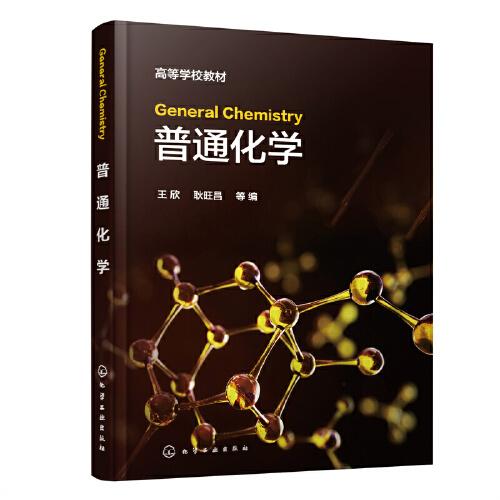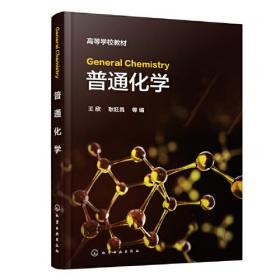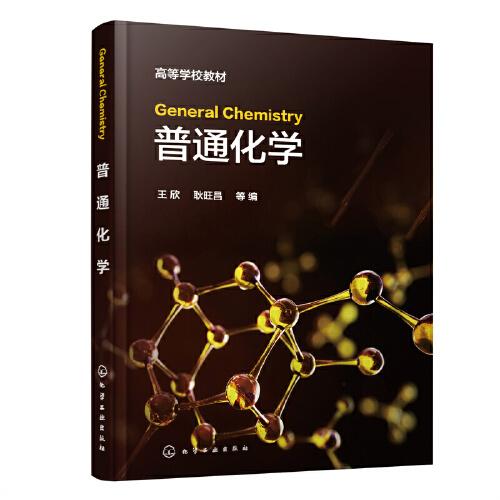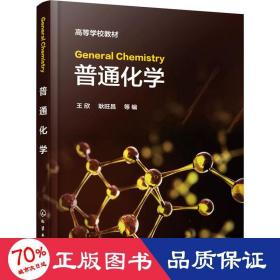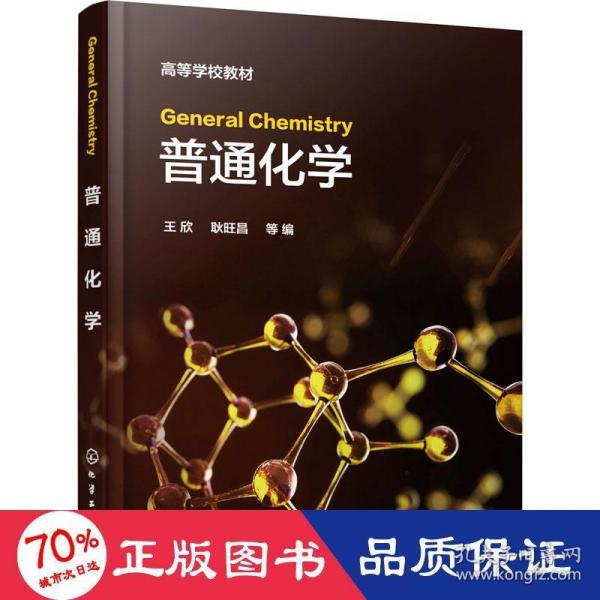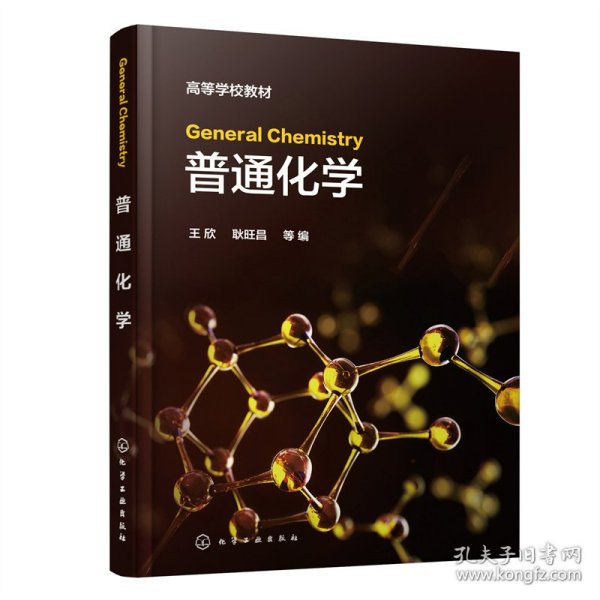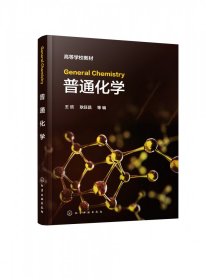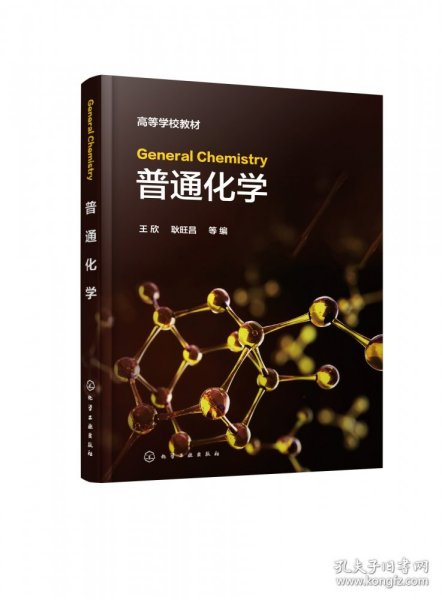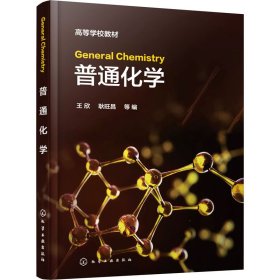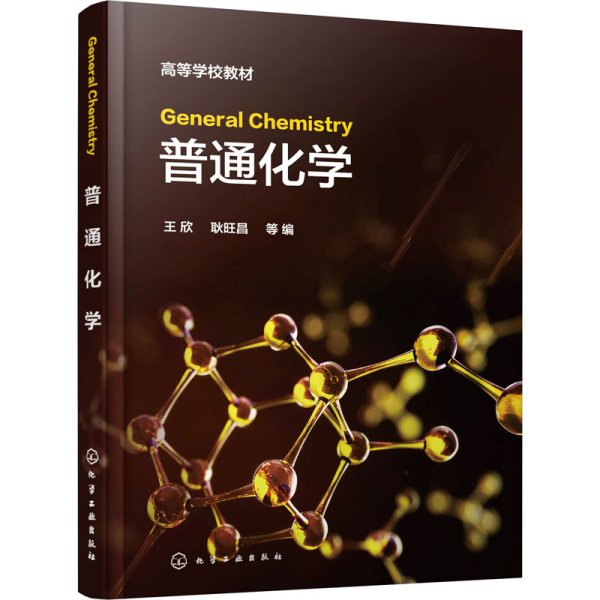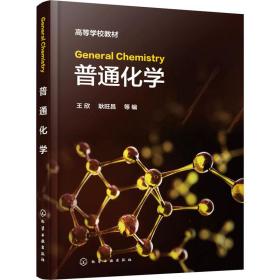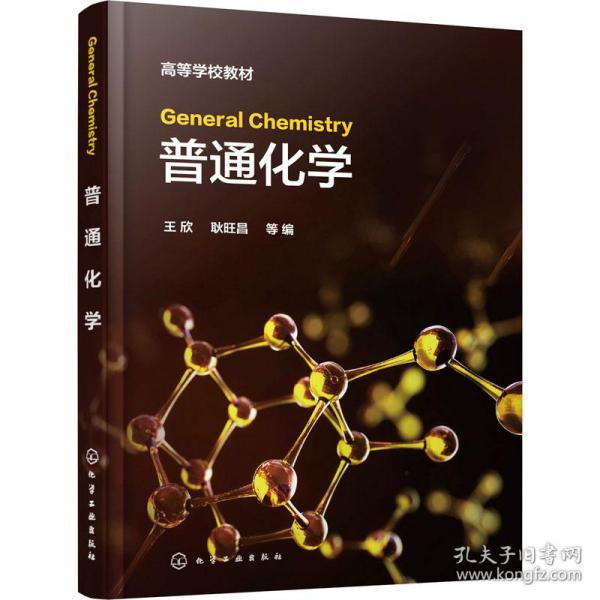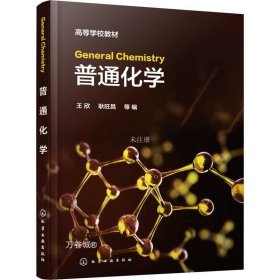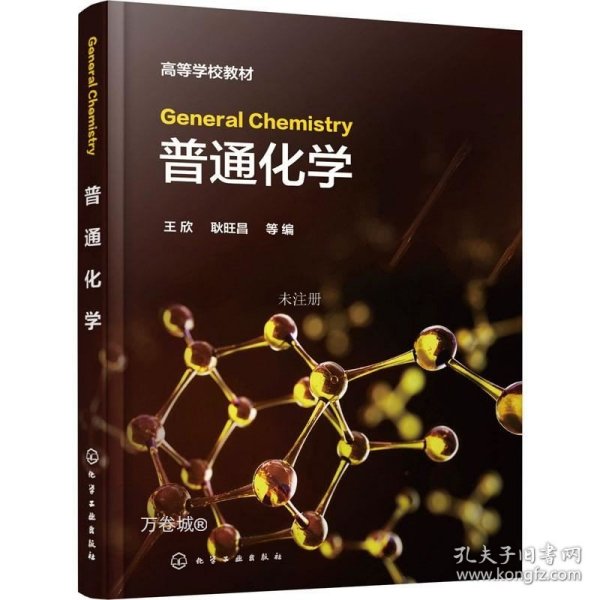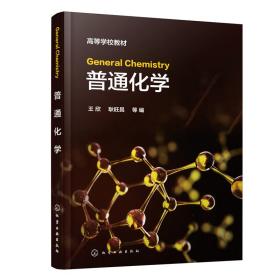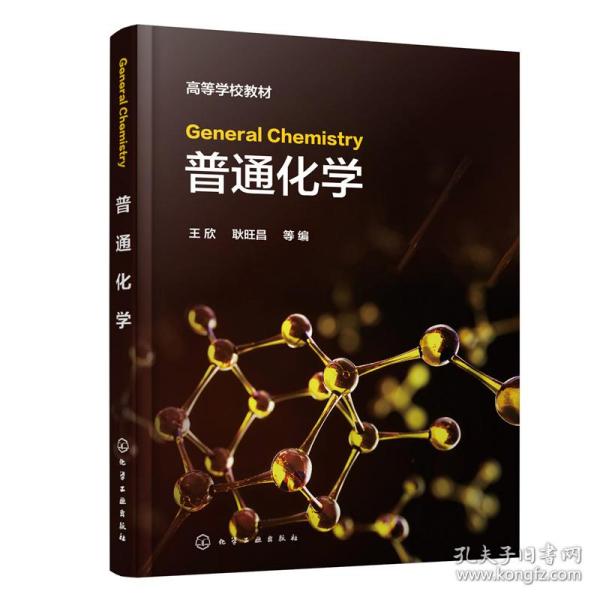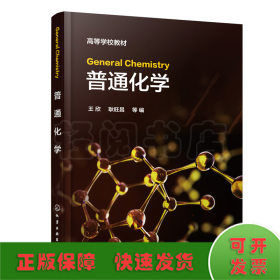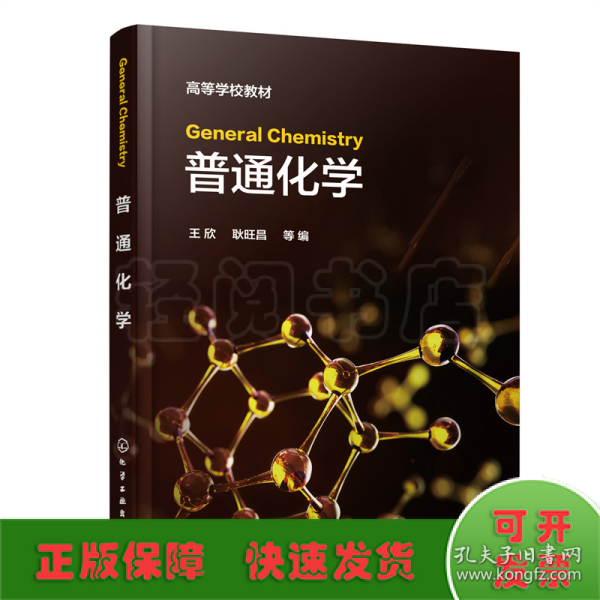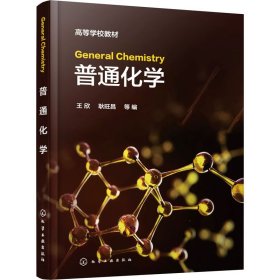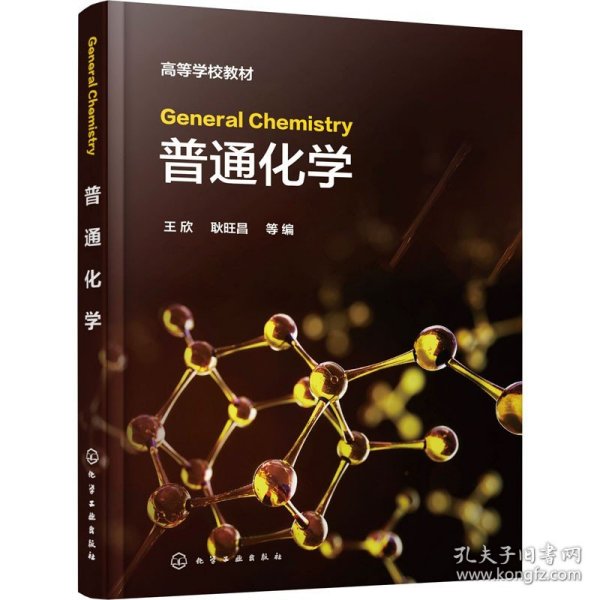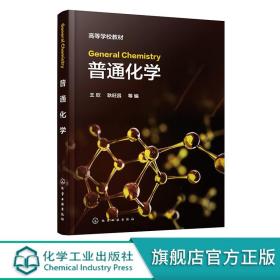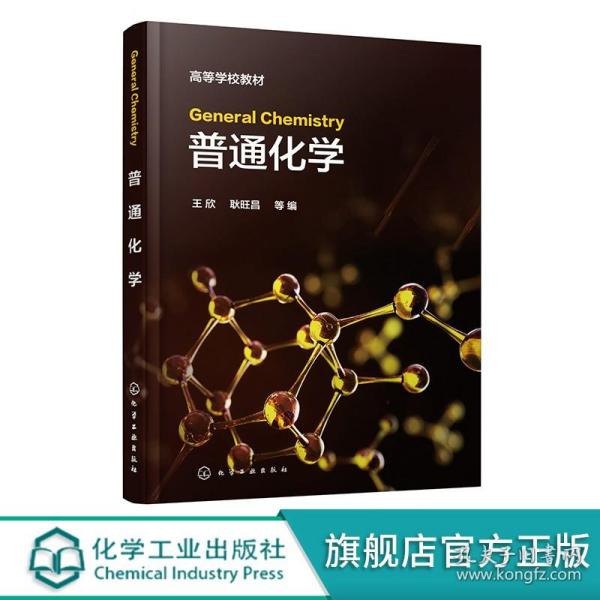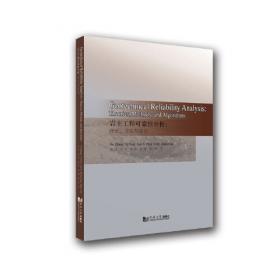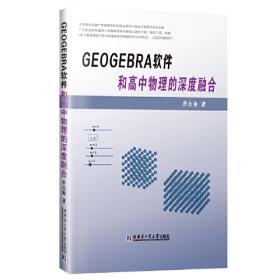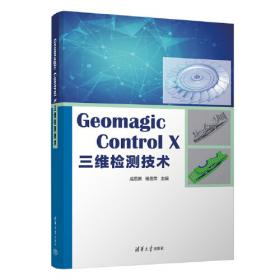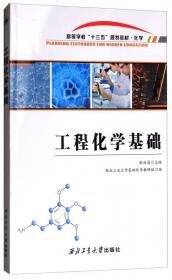General Chemistry(王欣)()
出版时间:
2022-09
版次:
1
ISBN:
9787122413659
定价:
88.00
装帧:
平装
开本:
16开
纸张:
胶版纸
页数:
308页
字数:
444千字
1人买过
-
General Chemistry(《普通化学》)根据我国高等院校工科专业学生对化学学习的需求及特点编写而成。书中从物质结构出发,阐明组成物质的原子及分子结构及其作用力,结合热力学、动力学、溶液、电化学、配位化学等基本化学原理,探讨当今迅速发展的材料、能源、环境、信息、国防等工程领域中的一些化学应用问题。本书内容精而不简,通用性强,注重可靠性、规范性的同时体现先进性和创新性。本书可作为高等院校各工科专业的全英文或双语化学基础课教学用书,也可供自学者、工程技术人员参考使用。 Chapter 1 Introduction 1
1.1 The Purpose of Chemistry Research and Its Brief History 1
1.1.1 What Is Chemistry? 1
1.1.2 A Brief History of Chemistry 2
1.2 Modern Chemistry and High Technology 4
1.2.1 Aerospace Technology 4
1.2.2 Energy and Environment 6
1.2.3 Flexible Electronic Technology 6
1.3 The Role, Status and Development Prospect of Chemistry 7
1.3.1 The Role and Status of Chemistry 7
1.3.2 The Development Prospect for Chemistry 8
Chapter 2 Chemical Composition and Aggregation of Substances 11
2.1 Chemical Composition of the Substance 11
2.2 Gases 12
2.2.1 Gas Phase 12
2.2.2 Ideal Gases 12
2.2.3 Gas Storage and Transportation 14
2.3 Liquids 15
2.3.1 Basic Properties of Liquids 15
2.3.2 Solution 17
2.4 Solids 18
2.4.1 Introduction of Solids 18
2.4.2 Crystal Characteristics 18
2.4.3 Types of Crystals 19
2.4.4 Solid’s Applications 22
2.5 Other Forms of Matter 22
2.5.1 Liquid Crystals 22
2.5.2 Supercritical State 23
2.5.3 Plasma State 24
2.6 Change of State 25
2.6.1 Three Phase Diagram of Pure Substance 25
2.6.2 Vaporization of Liquids 26
2.6.3 Liquefaction of Gases 27
2.6.4 Other State Changes 28
Exercises 28
Chapter 3 Atomic Structure and Periodic Table of Elements 30
3.1 Atomic Structure 30
3.1.1 Electrons in Atom 31
3.1.2 Bohr’s Theory of the Hydrogen 33
3.1.3 Schrodinger Equation for Hydrogen 35
3.1.4 The Shapes of the Orbitals 36
3.1.5 Electron Configurations 40
3.2 Chemical Elements and the Periodic Table 43
3.3 Atomic Chemical Properties 45
3.3.1 Atomic Radius 45
3.3.2 Ionization Energy 47
3.3.3 Electron Affinity 51
Exercises 52
Chapter 4 Chemical Bonding and Molecular Structure 54
4.1 Chemical Bonding 54
4.1.1 Lewis Theory 54
4.1.2 The Covalent Bond: A Quantum Mechanical Concept 56
4.1.3 Introduction to the Valence Bond Method 57
4.1.4 Characteristics of Covalent Bond 57
4.1.5 Types of Covalent Bond 58
4.1.6 Bond Parameters 59
4.2 Valence-Shell Electron-Pair Repulsion (VSEPR) Theory 62
4.3 Hybrid Orbital Theory and Molecular Structure 64
4.3.1 Hybrid Orbital Theory 64
4.3.2 Hybridization Scheme 64
4.4 Molecular Polarity and Polarization 67
4.4.1 Polar Covalent Bond and Nonpolar Covalent Bond 67
4.4.2 Dipole Moment and Molecular Polarity 68
4.4.3 Molecular Polarization 69
4.5 Intermolecular Forces 70
4.5.1 van der Waals Forces 70
4.5.2 Hydrogen Bonding 74
Exercises 78
Chapter 5 Heat Effect of Chemical Reaction and Energy Utilization 79
5.1 The First Law of Thermodynamics 79
5.1.1 Some Thermodynamic Terminology 79
5.1.2 The First Law of Thermodynamics 87
5.2 Heat Interaction During Chemical Process 88
5.2.1 Heats of Reaction 89
5.2.2 Enthalpy Change of Reaction: ΔrHm 91
5.2.3 Enthalpy Change Accompanying a Change in State of Matter 93
5.2.4 Standard States and Standard Enthalpies of Reaction 94
5.3 Hess’s Law and Its Applications 94
5.3.1 Hess’s Law and Applications 94
5.3.2 Basic Thermodynamics Data: Standard Molar Enthalpies of Formation 96
5.3.3 Standard Molar Combustion Enthalpy 99
5.4 Fuels as Sources of Energy 100
5.4.1 Solar Energy 101
5.4.2 Biomass Energy 104
5.4.3 Hydrogen Energy 105
5.4.4 Natural Gas Hydrate 108
Exercises 109
Chapter 6 Basic Principles of Chemical Reaction 111
6.1 Spontaneous Reaction and Entropy 111
6.1.1 Spontaneous Reaction and Its Thermal Effect 112
6.1.2 Entropy and the Direction of Spontaneous Reaction 113
6.2 Gibbs Function Changes and Judgment of Spontaneous Direction of Reaction 117
6.2.1 Gibbs Function Changes and Gibbs Function Criterion 117
6.2.2 Standard Molar Gibbs Function Variation of Reaction and Its Calculation 118
6.2.3 Application of Gibbs Formula 121
6.2.4 Gibbs Function Changes under Nonstandard Condition 124
6.3 Chemical Equilibrium 126
6.3.1 The Equilibrium Constant 127
6.3.2 The Main Factors Affecting the Chemical Equilibrium 132
6.4 Chemical Reaction Rate 139
6.4.1 Reaction Mechanisms 140
6.4.2 Effect of Concentration on Reaction Rate 144
6.4.3 Effect of Temperature on Reaction Rate 149
6.4.4 Effect of Catalyst on Reaction Rate 153
Exercises 158
Chapter 7 Solution and Ion Equilibrium 165
7.1 Colligative Properties 166
7.1.1 Vapor Pressure Lowering 166
7.1.2 Freezing Point Depression and Boiling Point Elevation 169
7.1.3 Osmotic Pressure of Solution 173
7.2 Weak Electrolyte Dissociation Equilibrium and Buffer Solution 175
7.2.1 The Development of Acid-Base Theory 175
7.2.2 The Self-ionization of Water and the pH Scale 177
7.2.3 Single-phase Dissociation Equilibrium: The Dissociation of Weak Acid and Weak Base 178
7.2.4 Buffer Solution 183
7.3 Precipitation Dissolution Equilibrium of Insoluble Strong Electrolytes 187
7.3.1 Solubility Product 187
7.3.2 Solubility Product Rules 189
Exercises 195
Chapter 8 Applied Electrochemistry 197
8.1 Voltaic Cell and Cell Diagram 197
8.1.1 Voltaic Cell 197
8.1.2 Electrode, Cell Reaction and Cell Diagram 199
8.2 Generation, Determination, Influencing Factors and Application of Electrode Potential 201
8.2.1 Generation of Electrode Potential: Electric Double Layer Theory 202
8.2.2 Measurement of Standard Electrode Potential 203
8.2.3 Nernst Equation: Effect of Concentration on Electrode Potential 208
8.2.4 Application of Electrode Potential and EMF 211
8.3 Electrolytic Cell 216
8.3.1 Composition and Electrode Reaction of Electrolytic Cells 216
8.3.2 Main Factors Affecting Electrode Reaction 217
8.3.3 Decomposition Voltage and over Voltage 221
8.3.4 General Law of Electrolytic Products 224
8.3.5 Application of Electrolysis 225
8.4 Chemical Power Supply 228
8.4.1 Classification of Chemical Power Sources 228
8.4.2 Electromotive Force, Open Circuit Voltage and Working Voltage of Chemical Power Supply 228
8.4.3 Voltaic Cells 229
8.4.4 Secondary Battery 231
8.4.5 Fuel Cells 232
8.4.6 Environmental Pollution Caused by Chemical Power Supply and
Its Treatment Measures 236
Exercises 238
Chapter 9 Corrosion and Material Protection 242
9.1 Principle and Rate of Metal Corrosion 242
9.1.1 Principle of Electrochemical Corrosion 243
9.1.2 Polarization of Corrosion Battery and Factors Affecting Corrosion Rate 244
9.2 Main Methods to Prevent Metal Corrosion 248
9.2.1 Improve the Anticorrosion Performance of Metal 248
9.2.2 The Use of Various Protective Layers 249
9.2.3 Corrosion Inhibitor Method 249
9.2.4 Electrochemical Protection 250
9.3 Protection of Polymer Materials 251
9.3.1 Influence Mechanism of Environmental Factors 252
9.3.2 Anti-aging Measures 255
9.4 Electronic Packaging Materials 257
9.4.1 Main Performance Requirements for Electronic Packaging Materials 257
9.4.2 Commonly Used Electronic Packaging Materials 258
9.4.3 Preparation Method of Metal-based Composite Electronic Packaging Materials 261
Exercises 262
Chapter 10 Metal Coordination Compound 263
10.1 Basic Concepts and Nomenclature 264
10.1.1 Coordinate Bonds and Coordination Compounds 264
10.1.2 Composition and Type of Complexes 264
10.1.3 Ligands 266
10.1.4 Naming Coordination Compounds 268
10.2 Complex Ion Equilibria 270
10.2.1 Dissociation Balance and Equilibrium Constant of Complex Ion 270
10.2.2 The Coordination Equilibria 272
10.3 The Chemical Bond Theory in Coordination Compounds 275
10.3.1 Valence Bond Theory 275
10.3.2 Crystal Field Theory (CFT) 278
10.4 Applications of Coordination Chemistry 283
10.4.1 Nitrogenase (Nitrogen Fixation) 283
10.4.2 Cisplatin: A Cancer-fighting Drug 284
10.4.3 Sequestering Metal Ions 285
10.4.4 Photosynthesis 286
10.4.5 Metalloprotein and Metalloenzyme 287
Exercises 290
Appendix 291
Ⅰ Some Basic Constants of Physics and Chemistry 291
Ⅱ Thermodynamic Properties of Substances at 298.15K 291
Ⅲ Dissociation Equilibrium Constants of Weak Electrolytes in Water at 298.15K 295
Ⅳ Solubility Product of Common Insoluble Electrolytes 297
Ⅴ Standard Electrode (Reduction) Potentials at 298.15K 298
Ⅵ Saturated Vapor Pressure of Water at Different Temperatures 302
Ⅶ Ground-state Electron Configurations 305
References 307
Periodic Table of the Elements 308
-
内容简介:
General Chemistry(《普通化学》)根据我国高等院校工科专业学生对化学学习的需求及特点编写而成。书中从物质结构出发,阐明组成物质的原子及分子结构及其作用力,结合热力学、动力学、溶液、电化学、配位化学等基本化学原理,探讨当今迅速发展的材料、能源、环境、信息、国防等工程领域中的一些化学应用问题。本书内容精而不简,通用性强,注重可靠性、规范性的同时体现先进性和创新性。本书可作为高等院校各工科专业的全英文或双语化学基础课教学用书,也可供自学者、工程技术人员参考使用。
-
目录:
Chapter 1 Introduction 1
1.1 The Purpose of Chemistry Research and Its Brief History 1
1.1.1 What Is Chemistry? 1
1.1.2 A Brief History of Chemistry 2
1.2 Modern Chemistry and High Technology 4
1.2.1 Aerospace Technology 4
1.2.2 Energy and Environment 6
1.2.3 Flexible Electronic Technology 6
1.3 The Role, Status and Development Prospect of Chemistry 7
1.3.1 The Role and Status of Chemistry 7
1.3.2 The Development Prospect for Chemistry 8
Chapter 2 Chemical Composition and Aggregation of Substances 11
2.1 Chemical Composition of the Substance 11
2.2 Gases 12
2.2.1 Gas Phase 12
2.2.2 Ideal Gases 12
2.2.3 Gas Storage and Transportation 14
2.3 Liquids 15
2.3.1 Basic Properties of Liquids 15
2.3.2 Solution 17
2.4 Solids 18
2.4.1 Introduction of Solids 18
2.4.2 Crystal Characteristics 18
2.4.3 Types of Crystals 19
2.4.4 Solid’s Applications 22
2.5 Other Forms of Matter 22
2.5.1 Liquid Crystals 22
2.5.2 Supercritical State 23
2.5.3 Plasma State 24
2.6 Change of State 25
2.6.1 Three Phase Diagram of Pure Substance 25
2.6.2 Vaporization of Liquids 26
2.6.3 Liquefaction of Gases 27
2.6.4 Other State Changes 28
Exercises 28
Chapter 3 Atomic Structure and Periodic Table of Elements 30
3.1 Atomic Structure 30
3.1.1 Electrons in Atom 31
3.1.2 Bohr’s Theory of the Hydrogen 33
3.1.3 Schrodinger Equation for Hydrogen 35
3.1.4 The Shapes of the Orbitals 36
3.1.5 Electron Configurations 40
3.2 Chemical Elements and the Periodic Table 43
3.3 Atomic Chemical Properties 45
3.3.1 Atomic Radius 45
3.3.2 Ionization Energy 47
3.3.3 Electron Affinity 51
Exercises 52
Chapter 4 Chemical Bonding and Molecular Structure 54
4.1 Chemical Bonding 54
4.1.1 Lewis Theory 54
4.1.2 The Covalent Bond: A Quantum Mechanical Concept 56
4.1.3 Introduction to the Valence Bond Method 57
4.1.4 Characteristics of Covalent Bond 57
4.1.5 Types of Covalent Bond 58
4.1.6 Bond Parameters 59
4.2 Valence-Shell Electron-Pair Repulsion (VSEPR) Theory 62
4.3 Hybrid Orbital Theory and Molecular Structure 64
4.3.1 Hybrid Orbital Theory 64
4.3.2 Hybridization Scheme 64
4.4 Molecular Polarity and Polarization 67
4.4.1 Polar Covalent Bond and Nonpolar Covalent Bond 67
4.4.2 Dipole Moment and Molecular Polarity 68
4.4.3 Molecular Polarization 69
4.5 Intermolecular Forces 70
4.5.1 van der Waals Forces 70
4.5.2 Hydrogen Bonding 74
Exercises 78
Chapter 5 Heat Effect of Chemical Reaction and Energy Utilization 79
5.1 The First Law of Thermodynamics 79
5.1.1 Some Thermodynamic Terminology 79
5.1.2 The First Law of Thermodynamics 87
5.2 Heat Interaction During Chemical Process 88
5.2.1 Heats of Reaction 89
5.2.2 Enthalpy Change of Reaction: ΔrHm 91
5.2.3 Enthalpy Change Accompanying a Change in State of Matter 93
5.2.4 Standard States and Standard Enthalpies of Reaction 94
5.3 Hess’s Law and Its Applications 94
5.3.1 Hess’s Law and Applications 94
5.3.2 Basic Thermodynamics Data: Standard Molar Enthalpies of Formation 96
5.3.3 Standard Molar Combustion Enthalpy 99
5.4 Fuels as Sources of Energy 100
5.4.1 Solar Energy 101
5.4.2 Biomass Energy 104
5.4.3 Hydrogen Energy 105
5.4.4 Natural Gas Hydrate 108
Exercises 109
Chapter 6 Basic Principles of Chemical Reaction 111
6.1 Spontaneous Reaction and Entropy 111
6.1.1 Spontaneous Reaction and Its Thermal Effect 112
6.1.2 Entropy and the Direction of Spontaneous Reaction 113
6.2 Gibbs Function Changes and Judgment of Spontaneous Direction of Reaction 117
6.2.1 Gibbs Function Changes and Gibbs Function Criterion 117
6.2.2 Standard Molar Gibbs Function Variation of Reaction and Its Calculation 118
6.2.3 Application of Gibbs Formula 121
6.2.4 Gibbs Function Changes under Nonstandard Condition 124
6.3 Chemical Equilibrium 126
6.3.1 The Equilibrium Constant 127
6.3.2 The Main Factors Affecting the Chemical Equilibrium 132
6.4 Chemical Reaction Rate 139
6.4.1 Reaction Mechanisms 140
6.4.2 Effect of Concentration on Reaction Rate 144
6.4.3 Effect of Temperature on Reaction Rate 149
6.4.4 Effect of Catalyst on Reaction Rate 153
Exercises 158
Chapter 7 Solution and Ion Equilibrium 165
7.1 Colligative Properties 166
7.1.1 Vapor Pressure Lowering 166
7.1.2 Freezing Point Depression and Boiling Point Elevation 169
7.1.3 Osmotic Pressure of Solution 173
7.2 Weak Electrolyte Dissociation Equilibrium and Buffer Solution 175
7.2.1 The Development of Acid-Base Theory 175
7.2.2 The Self-ionization of Water and the pH Scale 177
7.2.3 Single-phase Dissociation Equilibrium: The Dissociation of Weak Acid and Weak Base 178
7.2.4 Buffer Solution 183
7.3 Precipitation Dissolution Equilibrium of Insoluble Strong Electrolytes 187
7.3.1 Solubility Product 187
7.3.2 Solubility Product Rules 189
Exercises 195
Chapter 8 Applied Electrochemistry 197
8.1 Voltaic Cell and Cell Diagram 197
8.1.1 Voltaic Cell 197
8.1.2 Electrode, Cell Reaction and Cell Diagram 199
8.2 Generation, Determination, Influencing Factors and Application of Electrode Potential 201
8.2.1 Generation of Electrode Potential: Electric Double Layer Theory 202
8.2.2 Measurement of Standard Electrode Potential 203
8.2.3 Nernst Equation: Effect of Concentration on Electrode Potential 208
8.2.4 Application of Electrode Potential and EMF 211
8.3 Electrolytic Cell 216
8.3.1 Composition and Electrode Reaction of Electrolytic Cells 216
8.3.2 Main Factors Affecting Electrode Reaction 217
8.3.3 Decomposition Voltage and over Voltage 221
8.3.4 General Law of Electrolytic Products 224
8.3.5 Application of Electrolysis 225
8.4 Chemical Power Supply 228
8.4.1 Classification of Chemical Power Sources 228
8.4.2 Electromotive Force, Open Circuit Voltage and Working Voltage of Chemical Power Supply 228
8.4.3 Voltaic Cells 229
8.4.4 Secondary Battery 231
8.4.5 Fuel Cells 232
8.4.6 Environmental Pollution Caused by Chemical Power Supply and
Its Treatment Measures 236
Exercises 238
Chapter 9 Corrosion and Material Protection 242
9.1 Principle and Rate of Metal Corrosion 242
9.1.1 Principle of Electrochemical Corrosion 243
9.1.2 Polarization of Corrosion Battery and Factors Affecting Corrosion Rate 244
9.2 Main Methods to Prevent Metal Corrosion 248
9.2.1 Improve the Anticorrosion Performance of Metal 248
9.2.2 The Use of Various Protective Layers 249
9.2.3 Corrosion Inhibitor Method 249
9.2.4 Electrochemical Protection 250
9.3 Protection of Polymer Materials 251
9.3.1 Influence Mechanism of Environmental Factors 252
9.3.2 Anti-aging Measures 255
9.4 Electronic Packaging Materials 257
9.4.1 Main Performance Requirements for Electronic Packaging Materials 257
9.4.2 Commonly Used Electronic Packaging Materials 258
9.4.3 Preparation Method of Metal-based Composite Electronic Packaging Materials 261
Exercises 262
Chapter 10 Metal Coordination Compound 263
10.1 Basic Concepts and Nomenclature 264
10.1.1 Coordinate Bonds and Coordination Compounds 264
10.1.2 Composition and Type of Complexes 264
10.1.3 Ligands 266
10.1.4 Naming Coordination Compounds 268
10.2 Complex Ion Equilibria 270
10.2.1 Dissociation Balance and Equilibrium Constant of Complex Ion 270
10.2.2 The Coordination Equilibria 272
10.3 The Chemical Bond Theory in Coordination Compounds 275
10.3.1 Valence Bond Theory 275
10.3.2 Crystal Field Theory (CFT) 278
10.4 Applications of Coordination Chemistry 283
10.4.1 Nitrogenase (Nitrogen Fixation) 283
10.4.2 Cisplatin: A Cancer-fighting Drug 284
10.4.3 Sequestering Metal Ions 285
10.4.4 Photosynthesis 286
10.4.5 Metalloprotein and Metalloenzyme 287
Exercises 290
Appendix 291
Ⅰ Some Basic Constants of Physics and Chemistry 291
Ⅱ Thermodynamic Properties of Substances at 298.15K 291
Ⅲ Dissociation Equilibrium Constants of Weak Electrolytes in Water at 298.15K 295
Ⅳ Solubility Product of Common Insoluble Electrolytes 297
Ⅴ Standard Electrode (Reduction) Potentials at 298.15K 298
Ⅵ Saturated Vapor Pressure of Water at Different Temperatures 302
Ⅶ Ground-state Electron Configurations 305
References 307
Periodic Table of the Elements 308
查看详情
-
普通化学
按标题名购买,批量下载图片有时不对应,多本图片为其中一本,有问题请联系客服。
全新
河北省保定市
平均发货25小时
成功完成率89.1%
-
全新
北京市丰台区
平均发货23小时
成功完成率88.43%
-
普通化学、
全新正版书籍,假一罚十(图片为标准图,仅供参考。以标题为准,不了解的可以询问客服。) 可开发票
全新
北京市朝阳区
平均发货18小时
成功完成率94.92%
-
全新
天津市西青区
平均发货14小时
成功完成率90.27%
-
全新
天津市津南区
平均发货13小时
成功完成率94.5%
-
普通化学
正版新书 新华官方库房直发 可开电子发票
全新
江苏省南京市
平均发货8小时
成功完成率96.63%
-
九品
北京市昌平区
平均发货23小时
成功完成率86.41%
-
全新
广东省广州市
平均发货20小时
成功完成率86.4%
-
普通化学(
全新正版书籍,假一罚十(图片为标准图,仅供参考。以标题为准,不了解的可以询问客服。) 可开发票
全新
北京市朝阳区
平均发货16小时
成功完成率96.15%
-
普通化学(
全新正版书籍,假一罚十(图片为标准图,仅供参考。以标题为准,不了解的可以询问客服。) 可开发票
全新
北京市朝阳区
平均发货18小时
成功完成率94.92%
-
全新
江苏省无锡市
平均发货10小时
成功完成率93.42%
-
2023-01 印刷
九五品
河北省廊坊市
平均发货13小时
成功完成率94.77%
-
全新
河北省保定市
平均发货25小时
成功完成率74.54%
-
全新
江苏省苏州市
平均发货9小时
成功完成率95.6%
-
全新
山东省济宁市
平均发货67小时
成功完成率81.29%
-
全新
浙江省嘉兴市
平均发货10小时
成功完成率94.14%
-
全新
四川省成都市
平均发货15小时
成功完成率90.89%
-
全新
天津市河东区
平均发货28小时
成功完成率90.53%
-
全新
北京市东城区
平均发货29小时
成功完成率84.72%
-
全新
江苏省无锡市
平均发货18小时
成功完成率92.79%
-
全新
广东省广州市
平均发货8小时
成功完成率94.72%
-
全新
四川省成都市
平均发货25小时
成功完成率87.37%
-
全新
江苏省无锡市
平均发货8小时
成功完成率95.88%
-
全新
江苏省无锡市
平均发货18小时
成功完成率94.5%
-
普通化学
正版新书 新华官方库房直发 可开电子发票
全新
江苏省南京市
平均发货7小时
成功完成率98.16%
-
普通化学
正版新书 新华官方库房直发 可开电子发票
全新
江苏省南京市
平均发货15小时
成功完成率83.08%
-
全新
北京市房山区
平均发货18小时
成功完成率97.2%
-
全新
北京市通州区
平均发货10小时
成功完成率88.09%
-
全新
河北省保定市
平均发货15小时
成功完成率91.27%
-
全新
北京市朝阳区
平均发货9小时
成功完成率96.85%
-
全新
广东省广州市
平均发货17小时
成功完成率86.46%
-
全新
广东省广州市
平均发货19小时
成功完成率86.17%
-
全新
北京市朝阳区
平均发货13小时
成功完成率93.44%
-
全新
北京市东城区
平均发货11小时
成功完成率95.94%
-
全新
广东省广州市
平均发货7小时
成功完成率89.44%
-
全新
四川省成都市
平均发货10小时
成功完成率94.06%
-
全新
北京市房山区
平均发货22小时
成功完成率73.08%
-
全新
浙江省嘉兴市
平均发货13小时
成功完成率91.92%
-
全新
浙江省杭州市
平均发货30小时
成功完成率71.84%
-
全新
河北省保定市
平均发货23小时
成功完成率58.62%
-
全新
北京市东城区
平均发货21小时
成功完成率71.54%
-
全新
上海市浦东新区
平均发货27小时
成功完成率71.32%

 占位居中
占位居中

